MCP608T-I/ST Microchip Technology, MCP608T-I/ST Datasheet - Page 12

MCP608T-I/ST
Manufacturer Part Number
MCP608T-I/ST
Description
IC OPAMP 2.5V R-R W/CS 8TSSOP
Manufacturer
Microchip Technology
Specifications of MCP608T-I/ST
Slew Rate
0.08 V/µs
Amplifier Type
General Purpose
Number Of Circuits
1
Output Type
Rail-to-Rail
Gain Bandwidth Product
155kHz
Current - Input Bias
1pA
Voltage - Input Offset
250µV
Current - Supply
18.7µA
Current - Output / Channel
17mA
Voltage - Supply, Single/dual (±)
2.5 V ~ 6 V
Operating Temperature
-40°C ~ 85°C
Mounting Type
Surface Mount
Package / Case
8-TSSOP
Op Amp Type
Low Power
No. Of Amplifiers
1
Bandwidth
155kHz
Supply Voltage Range
2.5V To 5.5V
Amplifier Case Style
TSSOP
No. Of Pins
8
Number Of Channels
1
Voltage Gain Db
121 dB
Common Mode Rejection Ratio (min)
75 dB
Input Offset Voltage
0.25 mV
Operating Supply Voltage
3 V, 5 V
Maximum Operating Temperature
+ 85 C
Mounting Style
SMD/SMT
Minimum Operating Temperature
- 40 C
Lead Free Status / RoHS Status
Lead free / RoHS Compliant
-3db Bandwidth
-
Lead Free Status / Rohs Status
Details
Available stocks
Company
Part Number
Manufacturer
Quantity
Price
Company:
Part Number:
MCP608T-I/ST
Manufacturer:
MICROCHIP
Quantity:
12 000
Part Number:
MCP608T-I/ST
Manufacturer:
MICROCHIP/微芯
Quantity:
20 000
MCP606/7/8/9
After selecting R
resulting frequency response peaking and step
response overshoot. Modify R
response is reasonable. Bench evaluation and simula-
tions with the MCP606/7/8/9 SPICE macro model are
helpful.
4.4
The MCP608 is a single op amp with Chip Select (CS).
When CS is pulled high, the supply current drops to
50 nA (typ.) and flows through the CS pin to V
this happens, the amplifier output is put into a high-
impedance state. By pulling CS low, the amplifier is
enabled. If the CS pin is left floating, the amplifier may
not operate properly. Figure 1-1 shows the output
voltage and supply current response to a CS pulse.
4.5
With this family of operational amplifiers, the power
supply pin (V
bypass capacitor (i.e., 0.01 µF to 0.1 µF) within 2 mm
for good high-frequency performance. It also needs a
bulk capacitor (i.e., 1 µF or larger) within 100 mm to
provide large, slow currents. This bulk capacitor can be
shared with other nearby analog parts.
4.6
In applications where low input bias current is critical,
Printed Circuit Board (PCB) surface-leakage effects
need to be considered. Surface leakage is caused by
humidity, dust or other contamination on the board.
Under low humidity conditions, a typical resistance
between nearby traces is 10
cause 5 pA of current to flow, which is greater than the
MCP606/7/8/9 family’s bias current at 25°C (1 pA, typ.).
The easiest way to reduce surface leakage is to use a
guard ring around sensitive pins (or traces). The guard
ring is biased at the same voltage as the sensitive pin.
An example of this type of layout is shown in Figure 4-4.
FIGURE 4-4:
for Inverting Gain.
DS11177D-page 12
MCP608 Chip Select (CS)
Supply Bypass
PCB Surface Leakage
DD
for single-supply) should have a local
ISO
V
for your circuit, double-check the
IN
Guard Ring
Example Guard Ring Layout
-
12
. A 5V difference would
V
ISO
IN
+
’s value until the
V
SS
SS
. When
1.
2.
4.7
4.7.1
The MCP606/7/8/9 op amps can be used to sense the
load current on the low-side of a battery using the
circuit in Figure 4-5. In this circuit, the current from the
power supply (minus the current required to power the
MCP606) flows through a sense resistor (R
converts it to voltage. This is gained by the the amplifier
and resistors, R
of the amplifier is at the load’s negative supply (V
the gain from R
FIGURE 4-5:
Sensor.
Since the input bias current and input offset voltage of
the MCP606 are low, and the input is capable of swing-
ing below ground, there is very little error generated by
the amplifier. The quiescent current is very low, which
helps conserve battery power. The rail-to-rail output
makes it possible to read very low currents.
Non-inverting Gain and Unity-gain Buffer:
a)
b)
Inverting Gain and Transimpedance Gain
(convert current to voltage, such as photo
detectors) amplifiers:
a)
b)
2.5V
5.5V
to
Connect the non-inverting pin (V
input with a wire that does not touch the
PCB surface.
Connect the guard ring to the inverting input
pin (V
common mode input voltage.
Connect the guard ring to the non-inverting
input pin (V
to the same reference voltage as the op
amp (e.g., V
Connect the inverting pin (V
with a wire that does not touch the PCB
surface.
Application Circuits
V
LOW-SIDE BATTERY CURRENT
SENSOR
OUT
IN
SEN
G
R
5 k
10
–). This biases the guard ring to the
R
SEN
and R
=
G
to V
V
IN
DD
LM
+). This biases the guard ring
Low Side Battery Current
F
OUT
© 2005 Microchip Technology Inc.
/2 or ground).
50 k
+
. Since the non-inverting input
R
I
MCP606
L
F
is R
R
SEN
F
/R
R F
G
IN
.
–) to the input
R
G
IN
SEN
+) to the
To Load
To Load
(V
(V
I
), which
V
L
LM
LP
OUT
)
)
LM
),













